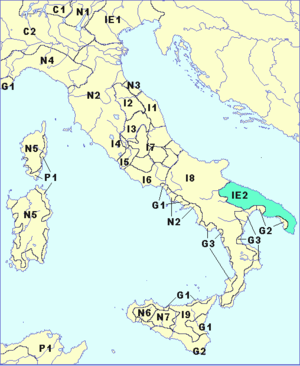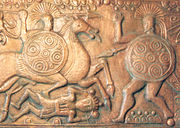- Messapian language
-
Messapian, Messapic Spoken in Puglia region of Italy Extinct around 1st century BC Language family Indo-European- Messapian, Messapic
Language codes ISO 639-3 cms 
Messapian (also known as Messapic) is an extinct Indo-European language of South-eastern Italy, once spoken in the region of Apulia. It was spoken by the three Iapygian tribes of the region: the Messapians, the Dauni and the Peucetii.
The language has been preserved in about 300 inscriptions dating from the 6th to the 1st century BC.
Messapian may have been one of the Illyrian languages, which were spoken mainly on the other side of the Adriatic Sea. This speculation is based on personal names found on tomb inscriptions and on classical references, since hardly any traces of the Illyrian language are left.
Messapian became extinct after the Roman Republic conquered the region of Apulia and assimilated the inhabitants.
Contents
Inscriptions
Few if any Messapic inscriptions have been definitely deciphered.
From the Vaste inscription (Corpus Inscriptionum Messapicarum 149), a passage that probably consists mostly of personal names:
- klohi zis thotoria marta pido vastei basta veinan aran in daranthoa vasti staboos xohedonas daxtassi vaanetos inthi trigonoxo a staboos xohetthihi dazimaihi beiliihi inthi rexxorixoa kazareihi xohetthihi toeihithi dazohonnihi inthi vastima daxtas kratheheihi inthi ardannoa poxxonnihi a imarnaihi
For this other Messapic inscription (Grotta della Poesia, Melendugno, Lecce), a translation is given from Cornell University:
- klauhi Zis
- Dekias Artahias
- Thautouri andirahho
- daus apistathi vinaihi
- Hear Zeus,
- Dekias Artahias
- to the infernal Thaotor
- set up (the rest untranslated)
Here, klauhi probably means "hear" (<PIE *kleu-, "to hear"); Zis has been interpreted as the Messapic Zeus; Dekias is a first name (compare Latin Decius); Artahias is a patronym or nomen gentile with the Messapic genitive -as suffix; Thautori is inferred to be an infernal god because of its placement next to what appears to be an adjective, andirahho (perhaps from PIE *ndher-, "under"). The name is similar to Tartarus, a classical name for the realm of Hades.
Another Messapic inscription from Galatina is dated to the 2nd century BC:
- klohi zis anthos thotorridas ana aprodita apa ogrebis
The separation of the last two elements is uncertain (apa, ogrebis, as shown here). Klohi (as klauhi in the preceding inscription) probably means "listen, hear". Zis may be the Messapic Zeus, as in the preceding inscription. Aprodita is a loanword from Greek Aphrodite. Anthos Thotorridas is a Messapic anthroponym, showing a personal name plus patronymic or nomen gentile in the genitive (-as). It may be related to "Thautori", mentioned in the Vaste inscription.
The Messapian language is preserved in a scanty group of perhaps fifty inscriptions, of which only a few contain more than proper names, and in a few glosses in ancient writers collected by Mommsen (Unteritalische Dialekte, p. 70). Unluckily very few originals of the inscriptions are now in existence, though some few remain in the museum at Taranto. The only satisfactory transcripts are those given by:
- Mommsen (loc. cit.)
- John P Droop in the Annual of the British School at Athens (1905–1906), xli. 137, who includes, for purposes of comparison, as the reader should be warned, some specimens of the 'unfortunately numerous class of forged inscriptions.
A large number of the inscriptions collected by Gamurrini in the appendices to Fabretti's Corpus inscriptionum italicarum are forgeries, and the text of the rest is negligently reported. It is therefore safest to rely on the texts collected by Mommsen, cumbered though they are by the various readings given to him by various authorities. Despite these difficulties, however, some facts of considerable importance have been established.
The inscriptions, so far as it is safe to judge from the copies of the older finds and from Droop's facsimiles of the newer, are all in the Tarentine-Ionic alphabet (with <no font for this character> for v and <no font for this character> for h)[clarification needed]. For limits of date 400-150 BC may be regarded as approximately probable; the two most important inscriptions—those of Brindisi and Vaste may be assigned, provisionally, to the 3rd century BC. Mommsen's first attempt at dealing with the inscriptions and the language attained solid, if not very numerous, results, chief of which were the genitival character of the endings -aihi and -ihi; and the conjunctional value of inthi (loc. cit. 79-84 sg(1).
Since 1850 little progress has been made. The Norwegian scholar Alf Torp (1853–1916) in Indogermanische Forschungen (1895), V, 195, deals fully with the two inscriptions just mentioned, and practically sums up all that is either certain or probable in the conjectures of his predecessors. Hardly more than a few words can be said to have been separated and translated with certainty--kalatoras (masc. gen. sing.) "of a herald" (written upon a herald's staff that was once in the Naples Museum); aran (acc: sing. fem.) "arable land"; mazzes, "greater" (neut. acc. sing.), the first two syllables of the Latin maiestas; while tepise (3rd sing. aorist indic.) "placed" or "offered"; and forms corresponding to the article (ta = Greek to) seem also probable.
Some phonetic characteristics of the language may be regarded as quite certain:
- the change of PIE short -ǒ- to -ǎ- (as in the last syllable of the genitive kalatoras)
- of final -m to -n (as in aran)
- of -ni- to -nn- (as in the Messapian praenomen Dazohonnes vs. the Illyrian praenomen Dazonius; the Messapian genitive Dazohonnihi vs. Illyrian genitive Dasonii, etc.)
- of -ti- to -tth- (as in the Messapian praenomen Dazetthes vs. Illyrian Dazetius; the Messapian genitive Dazetthihi vs. the Illyrian genitive Dazetii; from a Dazet- stem common in Illyrian and Messapian)
- of -si- to -ss- (as in Messapian Vallasso for Vallasio, a derivative from the shorter name Valla)
- the loss of final -d (as in tepise), and probably of final -t (as in -des, perhaps meaning "set", from PIE *dhe-, "to set, put")
- the change of voiced aspirates in Proto-Indo-European to plain voiced consonants: PIE *dh- or *-dh- to d- or -d- (Mes. anda < PIE *en-dha- < PIE *en-, "in"; compare Gr. entha) and PIE *bh- or *-bh- to b- or -b- (Mes. beran <PIE *bher-, "to bear")
- -au- before (at least some) consonants becomes -ā-: Bāsta, from Bausta
- the form penkaheh—which Torp very probably identifies with the Oscan stem pompaio--a derivative of the Proto-Indo-European numeral *penkwe-, "five".
If this last identification be correct it would show, that in Messapian (as in Venetic) the original labiovelars (kw, gw, ghw) were retained as gutturals and not converted into labials. The change of o to a is exceedingly interesting, being associated with the northern branches of Indo-European such as Germanic, Albanian and Lithuanian, and not appearing in any other southern dialect hitherto known.[citation needed] The Greek Aphrodite appears in the form Aprodita (dat. sing., fem.). The use of double consonants, which has been already pointed out in the Messapian inscriptions, has been very acutely connected by Deecke with the tradition that the same practice was introduced at Rome by the poet Ennius who came from the Messapian town Rudiae (Festus, p. 293 M).
The proper names in the inscriptions show the regular Italic system of gentile nomen preceded by a personal praenomen; and that some inscriptions show the interesting feature that appears in the Tables of Heraclea of a crest or coat of arms, such as a triangle or an anchor, peculiar to particular families. The same reappears in the Iovilae of Capua and Cumae.
Messapian words
Messapian lexical item Proposed cognates Bréntion (from Messapian bréndon, bréntion) (Brindisi, Italy) Swedish brinde "elk", Latvian briêdis "deer", Lithuanian briedis, "elk", Old Prussian braydis, "elk",[1] Thracian Brendike [1] (which was a Thracian toponym located just east of Dikaia) Albanian bri, brî (pl. brirë, brinë) "horn; antler" [< late Proto-Albanian *brina < earlier *brena], or the Albanian word Dren for Deer.[2] The Messapian word is glossed early as "deer", then narrowed in meaning to a deer's head (cf. Strabo caput cervi), then possibly by metonymy to its antlers in early Albanian, and by extension any excrescence, thus modern "horn". Menzana cf. Albanian mëz "colt"[3] penkaheh Torp identifies this as the Messapian word for the number "five", from PIE *penkwe-, "five" (Lithuanian penki - five) Bibliography
- W. Deecke in a series of articles in the Rheinisches Museum, xxxvi. 576 sqq.; xxxvii. 373 sqq. ; xl. 131 sqq.; xlii. 226 sqq.
- S. Bugge, Bezzenbergers Beiträge, vol. 18.
- L. Ceci Notizie degli Scavi (1908), p. 86; and one or two others are recorded by Professor Viola, ibid. 1884, p. 128 sqq. and in Giornale degli Scavi di Pompei, vol. 4 (1878), pp. 70 sqq. The place-names of the district are collected by R. S. Conway, The Italic Dialects, p. 31; for the Tarentine-Ionic alphabet see ibid. ii., 461.
For a discussion of the important ethnological question of the origin of the Messapians see:
- Wolfgang Helbig, Hermes, xi. 257
- P. Kretschmer, Einleitung in die Geschichte der griechischen Sprache, pp. 262 sqq., 272 sqq.
- H. Hirt, Die sprachliche Stellung der Illyrischen (Festschrift fur H. Kiepert, pp. 179–188)
 This article incorporates text from a publication now in the public domain: Chisholm, Hugh, ed (1911). Encyclopædia Britannica (11th ed.). Cambridge University Press.
This article incorporates text from a publication now in the public domain: Chisholm, Hugh, ed (1911). Encyclopædia Britannica (11th ed.). Cambridge University Press.See also
References
- ^ Orel, Vladimir. Albanian Etymological Dictionary. Leiden, Netherlands: Brill, 1998.
- ^ Orel, Vladimir. A Concise Historical Grammar of the Albanian Language: Reconstruction of Proto-Albanian. Leiden, Netherlands: Brill, 2000.
- ^ Verhandlungen des Zweiten Internationalen Dialektologenkongresses: Marburg/Lahn, 5.-10. September 1965, Volume 3 Issues 3-4 of Zeitschrift für Dialektologie und Linguistik Verhandlungen Des Zweiten Internationalen Dialektologenkongresses: Marburg/Lahn, 5.-10. September 1965, Ludwig Erich Schmitt Author Ludwig Erich Schmitt Publisher F. Steiner, 1968 p. 85
External links
- Civiltà messapica (Italian)
- Archaeologists find western world's oldest map. Telegraph Newspaper Online, November 19, 2005.
- Messapic
- Multitree at LINGUIST List; Unclassified Indo-European,Messapian
Illyrians-related topics Culture Tages · Daunian pottery · Messapian pottery · Peucetii pottery · Devollite pottery · Gradistë belt-plate · Trebeništa masks · Vače situla · Vače belt-plate · Soleto Map · Monte Saraceno woman · Illyrian religion · Illyrian clothing · Illyrian coinage · Illyrian fibulae · Spectacle brooch · Daunian stele · ]
]Warfare Illyrian Wars · Alexander's Balkan campaign · Great Illyrian Revolt · Sica · Sibyna · Illyrian type helmet · Enchele kingdom · LembosLanguage Cities Categories:- Ancient languages
- Indo-European languages
- Languages of ancient Italy
- Salento
Wikimedia Foundation. 2010.
